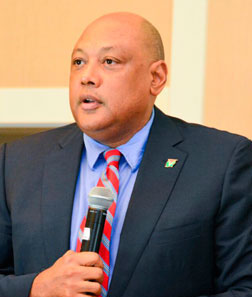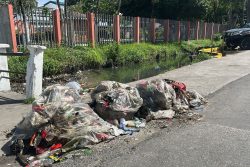Minster of Natural Resources Raphael Trotman has absolved himself of any responsibility for not expressing sooner that the lack of ring-fencing provisions in the Production Sharing Agreement with ExxonMobil’s subsidiary could negatively affect revenue earned by Guyana from the oil operations.
During an International Monetary Fund (IMF) delegation visit here earlier this month, government, for the first time, expressed concern that the lack of ring-fencing could negatively affect revenue earned from the agreement it signed with Esso Exploration and Production Guyana Limited (EEPGL) for the 6.6 million acres Stabroek Block.
“My only comment is that as a non-technical person, I was not the one to negotiate the contract, and that, at all material times, I acted on the advice and direction of the GGMC,” Trotman told Stabroek News.
“How could I see something as an indictment on myself if I didn’t draft it? I relied on the officers at GGMC at all times and was advised when the agreement was ready for signature,” he added when asked if he felt that given that he is an attorney and was minister responsible for the sector at the time the agreement was signed, that he should have let the President and Cabinet know about the absence of a ring-fencing arrangement.
The IMF’s mission Concluding Statement had said that “authorities indicated their concerns that the absence of a ring-fencing arrangement in the Stabroek Production Sharing Agreement (PSA) could potentially affect the projected flow of government oil revenues.”
According to the IMF, government has specifically noted that the rapid appraisal and development of multiple oil fields could affect the timing and amount of profit oil to be shared with the government from a producing oil field by allocating costs from various fields under development to the producing field.
In response, the IMF said that the authorities are developing strategies to mitigate such a possibility, including a national oil depletion policy to guide extraction and production and clearer ring-fencing rules for new investments.
The absence of a ring-fencing arrangement in the 2016 PSA has for years been discussed as a possible liability of Guyana’s developing oil sector. Such an arrangement would’ve put “a limitation on consolidation of income and deductions for tax purposes across different activities or different projects undertaken by the same taxpayer.”
Lacuna
Government’s admission of the ring-fencing lacuna is seen as an indictment of Trotman, who presided in secret over the renegotiation of the PSA with ExxonMobil’s subsidiary, EEPGL, without addressing a range of key issues.
Trotman had, at one time, described the new PSA as a “tweaking” of the earlier one but his handling of the process has come under severe criticism for not addressing matters such as ring-fencing, relinquishment of oil blocks, higher royalties and a bigger signing bonus. His being relieved of responsibility for the sector was seen in some quarters as a response to the various problems with the renegotiated PSA. Critics had said that the renegotiation was done without a single recognised expert on the Guyanese side capable of matching wits with ExxonMobil.
Jan Mangal, the former Petroleum Advisor to President David Granger, has said that Trotman was fully aware that he needed to hire oil and gas experts during the 2016 renegotiation of the contract with ExxonMobil and thus has put Guyana in a position where it has lost massive amounts via disastrous negotiations.
In a November 2017 report, the Fiscal Affairs Department (FAD) of the IMF had pointed out that ring-fencing in a PSA framework can limit the allocation of income and expenditure for profit oil sharing and tax purposes. With such a ring fence, the scope to consolidate income and expenditure across multiple fields is circumscribed.
“In the PSA framework in Guyana, the sharing of profit oil between the contractors and the government is done on a field by field basis. In principle, this ensures that the government revenue from the contract area is calculated based on each field separately. However, this is undone by the PSA framework also allowing the contractor to allocate cost oil to any field within the contract area.
“While Guyana does not place any restriction on the deductibility of interest under the ITA (Income Tax Act), it does impose a withholding tax on interest payments of 20 percent subject to double taxation treaties. Profit oil sharing linked to the cumulative rate of return in contrast would take into account the time value of money, although it is inherently difficult to determine the appropriate rate of return,” the report said.
It cautioned that this asymmetrical treatment of profit and cost oil is likely to benefit contractors with a number of fields within their contract areas at the expense of delaying government revenue. For example, it said that a contractor with multiple fields can significantly lower the amount of profit oil to be shared from a producing field by assigning cost oil from various fields under development to the producing field. This could have “significant implications” in terms of delaying government revenue, particularly if a large, multi-field project is launched in phases.
“Given the size of the contract area thus far awarded in Guyana, there is merit in applying a tighter ring-fencing arrangement as part of the general PSA framework. An option could be to apply this at the level of individual fields, perhaps only allowing failed exploration expenditures to be deducted against producing fields,” the FAD report stated.
Trotman laid responsibility for the absence of ring-fencing provisions on the GGMC saying that the same concerns would be raised for all other contracts since the GGMC contract template was used. “Please remember that GGMC used their standard form contract as the basis for that with Exxon and so the provisions would be basically the same for all the contracts we have and so if another company finds oil then the comments and criticisms about ring-fencing will be the same,” he said.
Technical caucus
But GGMC’s Head Newell Dennison had expressed, in a report he made in April 2016, following a meeting with ExxonMobil’s officials at their Houston, Texas office, that he was sent to a “technical caucus” when the renegotiation came up.
The report by Dennison also provided some insight into what would be seen as hard-nosed tactics by ExxonMobil where only Dennison and Manager of the then Petroleum Division, Christopher Lynch, attended as Guyana’s representatives.
Dennison said that EEPGL “confronted” the GGMC on the matter of their contract and licence.
“Esso then confronted with GGMC the matter of their Contract and Licence. This was anticipated some years prior when it was obvious that in the remainder of the licence term, all the exploration work to be done could not be achieved. This was despite their escalated intensity from 2008 when the Guyana/Suriname boundary resolution facilitated their return to activity.
“The discussed and accepted mechanism to deal with this situation was the use of a bridging Agreement while switching from the current licence and agreement to a new one. It was recognised that Esso was very uncomfortable with a transition. It requires an appreciation from Guyana’s side that Esso expects that the economics of (the) Liza prospect and Ranger, or whichever other discovery may emerge from the exploration drilling that is being done alongside “pre-appraisal” definition, during the remaining 2 years of the current agreement would be preserved. Esso is keen to ensure that there is a grandfather arrangement in that regard. (My perspective is that it would be a fair expectation and Esso should be given that assurance),” Dennison reported.
Dennison said that it was pointed out that the then agreement with Esso was in several ways out-of-date with what prevailed administratively in Guyana and that an approach to Esso in 2010/11 to deal with that was politely declined. The fact that Esso declined in 2010/11 – under the Bharrat Jagdeo administration – to amend the agreement will likely raise questions as to why it did not update then.
Rental
The GGMC Head had also reported proposals he put to the company. “I have put on the table that the rental would be significantly upgraded and opened at US$1 million per year. Esso was obviously ruffled but I believe my rationalization was sufficient for them to give serious consideration of it. We came to a position subject to Leadership’s approval that there would be the introduction of a signature bonus payable to a stated Government of Guyana Bank account for US$15 million, which caters to the associated issues.”
The signature bonus ended up being US$18 million. The annual rental fee for the block was upped to US$1 million from US$240,000. Dennison’s recounting of the signature bonus makes the point that it would be subject to ‘leadership’ approval, which would presumably be Cabinet.
It is still unclear, as government never sought to explain, why the issue of the signature bonus would be presented to Exxon at what was described as a “technical meeting.” How it was computed was also queried and Trotman had told the Parliamentary Sectoral Committee on Natural Resources that government determined the sum to pay for legal representation at the International Court of Justice’s case it has with Venezuela over the border controversy.
Trotman had said that all decisions taken in the contract were as part of a collective Cabinet.
“We determined, because we needed the sum of money for a particular purpose and that purpose is the hiring of the best lawyers,” he had told the committee.
He has said too that if he alone were responsible for the renegotiation of the PSA, it would have been done differently and stressed that “the decisions taken were… collective Cabinet decisions.”
“As I said before, my instructions were never to re-negotiate the PSA, so our discussions with Exxon were never with a view to have a renegotiation done. In fact, very early, the new government stated its position, that it would not seek to renegotiate contracts entered into by the previous administration. If my instructions were otherwise, I would have approached everything differently,” he said.
This newspaper understands that after the GGMC officials returned to Guyana and presented the report, they never heard about or saw the renegotiated contract until it was completed and ready for signature in June 2016 and the agency was not asked for further input.










